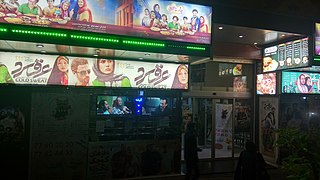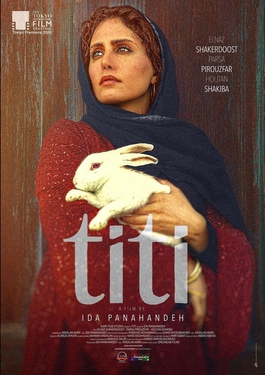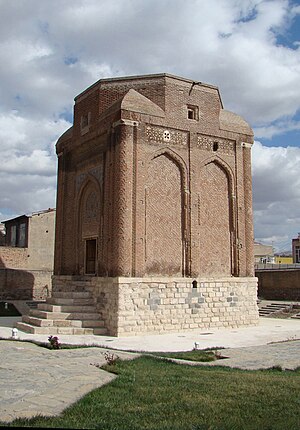
Saint Mary Church, Holy Mother of God Church or Surp Mariam Asdvadzadzin Church is an Armenian Apostolic church in Tabriz, East Azerbaijan Province, Iran completed in 1785. It is the largest and oldest Christian church in Tabriz and a notable centre for Armenian national and religious ceremonies held by the Armenian community of Tabriz.

Ayatollah Mohammad Feyz Sarabi was an Iranian Shiite cleric and politician. He was a member of the 4th and 5thAssembly of Experts from the East Azerbaijan electorate. Feyzi won his membership with 283,856 votes.

Order of Culture and Art is an Iranian state general order established by "Council of Iran Ministers" on November 21, 1990 and modified on June 27, 2007. The order has three classes and awarded by President of Iran. According to Article 17 of the Regulations on the Awarding of Government Orders of Iran, the Order of Culture and Art is awarded to those who "facilitate theirs thinking, passions and emotions to express deep Islamic and humanitarian concepts and to spread culture" in one of the following ways:
- Disseminating rich Islamic culture and eliminating society from foreign decadent culture
- Expanding the theoretical and disciplinary foundations of religious education
- Expanding national culture and revitalizing valuable social traditions
- Expressing creativity and presenting exquisite works of art or literature
- Pay particular attention to the country's cultural, artistic or literary heritage, so as to be effective in its restoration, preservation and utilization
- Introducing, describing, explaining, critiquing and presenting one of the artistic or literary disciplines internationally
- Inventing a new style in one of the artistic or literary disciplines
- Promote a culture of sacrifice and martyrdom in the community
- Creating remarkable and valuable artworks to convey the ideals and values of the Islamic Revolution and the Sacred Defense to future generations

35°42′33.8148″N51°26′9.6252″E
Eghtesad online in Persian is the first economic news agency in Iran which reviews news and provides analyses on economic issues in two languages: Persian and English. This economic news agency does not have any affiliation with Iran government or political parties & is financially independent.
Order of Research is one of the badges of honor in Iran, established by "Council of Iran Ministers" on November 21, 1990. According to "Article 8" of the "Regulations on the Awarding of Government Orders" of Iran, the "Order of Research" is awarded to individuals who have been the origin of fundamental transformation or rare service in the following ways:
- Introducing new research methods and techniques
- Studies and research that are the source of scientific change
- Finding new research methods
- Transfer of fundamental research to applied fields
- Every important innovation, originality, invention, and discovery
Abdolmohammad Ayati was an Iranian author, translator and researcher in the field of philosophy, history and Persian and Arabic literature. He was born on 5 May 1926 in Borujerd, Borujerd County, Lorestan Province, Iran and died on 11 September 2013 in Tehran, Iran. He was selected at the second Iran's Book of the Year Awards for Arabic to Persian translation of the book History of Arabic Language Literature.
Esmaeel Azar or Amir Esmaeel Azar is a professor of Persian literature and director of the Department of Persian Language at the Islamic Azad University, Science and Research Branch, Tehran, and director of the Farhangban Cultural and Artistic Institute. He also works as a presenter and expert on literary programs on Iran television, including the famous program called "Watching the Oath and the Beginning of the Word". He is a member of Art commission at the Supreme Council of the Cultural Revolution, Director of Persian Literature Department at the Economic Cooperation Organization, Member of the Naming Committee at the National Organization for Civil Registration of Iran, member of the scientific commissions of the Public Libraries of Iran and a member of the board of directors of the Comparative Literature Association of Iran.

The Iranology Foundation is a scientific and research institute in Iran and Iranian studies is the main field of its activities. The Foundation's studies and researches are all topics and issues related to various manifestations of Iranian culture and civilization. The institute was established in 1997 under the supervision of the Presidential Administration of Iran.

The Geological Survey and Mineral Exploration of Iran or in brief GSI is a government agency responsible for conducting geological and mineral surveys throughout the country, collecting the results of activities carried out in this field, establishing coordination, preparing and publishing geological maps of Iran. It is a subdivision of the Ministry of Industry, Mine and Trade, which was established in 1962 in cooperation with United Nations.

Behran Alavi is an Iranian actor. He has received various accolades, including nominations for a Crystal Simorgh and a Hafez Award.

Payam Ghobadi Oughaz is Iranian-born Azerbaijani taekwondo practitioner who currently plays for the Azerbaijani national taekwondo team.
Mahtab Servati is an Iranian actress. She is best known for her acting in There Is No Evil (2020), which won the Golden Bear at the 70th Berlin International Film Festival.

Skin is a 2020 Iranian fantasy horror drama film directed and written by Bahman Ark & Bahram Ark. The film screened for the first time at the 38th Fajr Film Festival and received 6 nominations and 2 awards including Best Film in Art & Experience Cinema and Best Original Score.

Vahid Rahbani is an Iranian actor, director, playwright, translator and author. He is best known for his role as Mohammad in Gando (2019–present). He earned a Crystal Simorgh nomination for his performance in Expediency (2021).

TiTi is a 2020 Iranian drama film directed by Ida Panahandeh and written by Panahandeh and Arsalan Amiri. The film screened for the first time at the 33rd Tokyo International Film Festival. In 2021, at the 39th Fajr Film Festival the film earned 3 nominations.

Esmaeil Mosafer is an Iranian volleyball player who plays as an Outside hitter for the Iranian national team and Iranian club Paykan Tehran VC and Kalleh Mazandaran VC.

The Ali Dome is an 11th-century mausoleum tower in Abarkuh, Iran. It was listed among the national heritage sites of Iran in 1933 with the registration number of 195.

Bahareh Afshari is an Iranian actress. She is best known for her role in She Was An Angel (2005). She earned a Hafez Award nomination for her performance in Distances (2010).
























